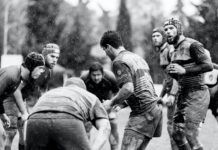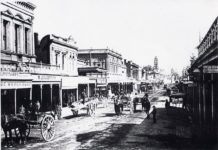Methodology and Philosophy (1950s – 1980’s)
- Formula / AIDA Selling – Use the same, fixed approach to get Attention, Interest, Desire and Action (1950s – David Ogilvy).
- Needs Satisfaction Selling – 7 step process to uncover needs and introduce benefits (1968 – Don Hammalian and Xerox Corporation).
- Strategic Selling – Use fixed planning process to highlight danger areas and penetrate decision-making process (1970s – Miller Heiman).
- Consultative Selling – Use in-depth questioning techniques to understand customer pain and then consult by helping buyer see impact for themselves (1980’s – Neil Rackham).
Late 1950’s – 1980’s
Towards the latter part of the 1950s salespeople were struggling. Although competition was not as intense as it is today, in a post-war society where factories were overproducing, merely to take up slack in their factory production, there was more product than buyers. Many organisations turned to marketing for assistance. And one of the major recommendations from marketing was to develop niche markets in order to enable sales to focus more effectively on potential buyers. The marketing argument was that if organisations clustered buyers into homogeneous segments – where their needs and behaviour were similar, if not totally identical – sales could develop a formula that would deliver greater success.
Formula Selling is a standardised (canned) approach to selling, based on a fixed sequence of steps, such as that outlined in the very popular “AIDA process”, which does not permit any variation due to changed circumstances or innovative ideas.
AIDA – which stands for Attention, Interest, Desire, Action – is the acronym for the standardised protocol used by salespeople to grab the Attention of a prospect, encourage an Interest in what the salesperson had to offer, stimulate a Desire to buy and then generate an Action which was committing to making a purchase. Although it became prevalent in the 1950s, Formula Selling is still very much in use today by telesales operators in call centres around the world. And AIDA still works in a simple and uncomplicated sales situation, where
the buyer is relatively uninformed and with products or services that are essentially commoditised.
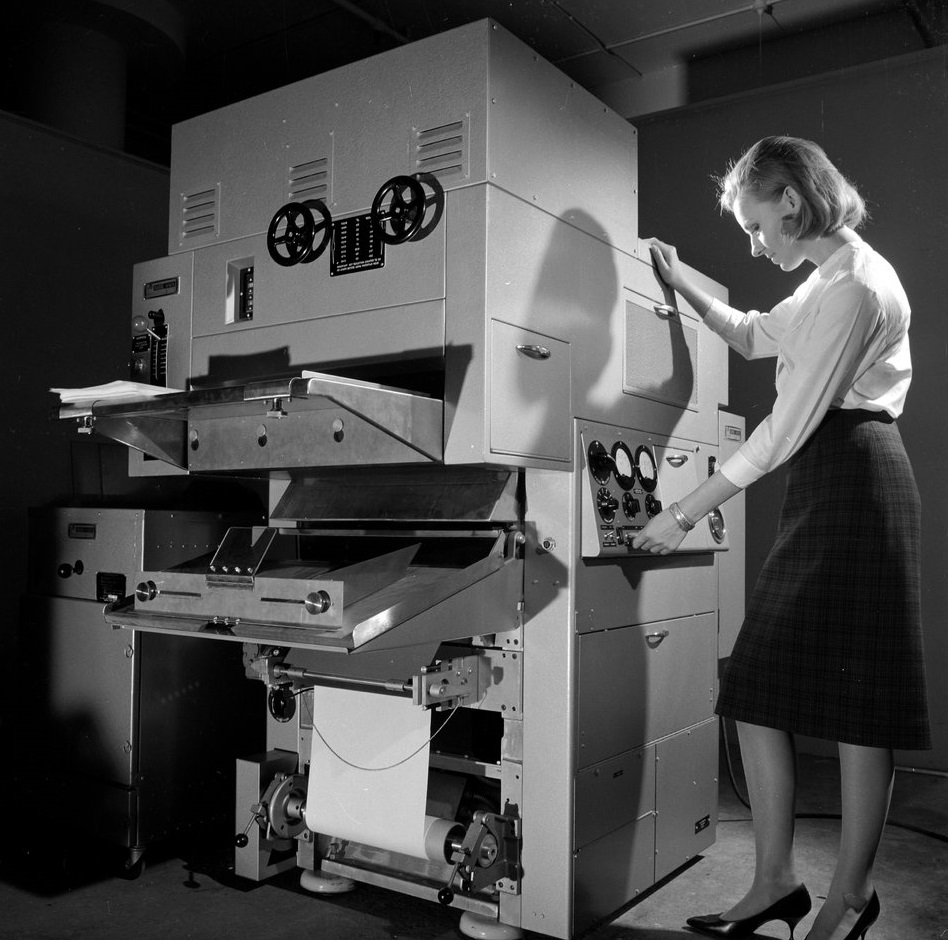
1968
Perhaps the most important evolution in selling took place in 1968 with the development of Needs Satisfaction Selling by Xerox Corporation of the United States.
Interestingly, the stimulus for this revolutionary sales methodology was the need to provide support and assistance to Xerox salespeople who were starting to lose deals to competition, as the Xerox patent on dryphotocopying came to an end.
Investing more than $10 million Xerox developed this powerful sales methodology and sales training programme – a concept that has influenced all training and sales methodologies ever since. The essence of this sales method was that almost nobody wanted to be sold anything. However, people did want to make informed decisions and it was the responsibility of professional salespeople to be in a position to a) understand what customers wanted, and b) be competent in explaining how the benefits of a product would help customers make that informed decision.
Needs Satisfaction Selling was the first structured sales process designed to facilitate the buyer’s decision-making process and assist salespeople overcome some of the resistance prospective customers may have and, at the same time, build stronger working relationships. The phenomenal success of the Xerox method of selling led the organisation to commercialise the concept. Xerox formed a new company (Xerox Learning Systems – XLS) in 1972 with the purpose of selling its sales method and training, known as Professional Selling Skills (PSS), together with a range of other sales development programmes (including speed reading, customer service skills, sales management and interviewing skills).
Don Hammalian who, along with Neill Rackham, was the co-author of PSS explained that at the time Xerox Corporation developed the sales method, it was looking for some way in which it could teach Xerox salespeople to sell solutions in what was rapidly becoming a complex, price sensitive and competitive environment. However, Hammalian did admit that in its initial iterations PSS was a highly manipulative model that was product focused and not one that should be advocated today.
Accepting that the number of steps in the sales method was somewhat arbitrary, Hammalian is justifiably proud that PSS / Needs Satisfaction Selling was the first programme of its type that introduced a sales philosophy, methodology and that was supported with a clear set of skills that could be learned using what was then the latest method in adult learning – Linear Learning.
This process, developed by Xerox and still very much in play today, includes the following seven stages:
- Planning the sales call
- Introduce yourself / company and start the sales call
- Asking questions and probing for insight into the prospect’s business
- Introduce benefits that would satisfy the needs of the customer
- Identify and handle objections and other buyer attitudes (scepticism
and indifference) - Close the deal and negotiate terms
- Follow up the call to ensure customer satisfaction
Since the commercialisation of Needs Satisfaction Selling (in PSS) in the 1970s more and more organisations have introduced different selling techniques, with supporting methodologies, styles and most importantly, training. In fact, one of the major differences between pre and post Needs Satisfaction Selling is that the sales methods developed prior to PSS were attempts (even if they were flawed) at finding ways to improve sales by improving methodologies. Post PSS the development of new sales methods seem to be more like sales training programmes.
Mid 1970s
Although by the mid-1970s customers were really enjoying the power of being better informed and having more choice, there was some gloom on the horizon. OPEC (Organisation of the Petroleum Exporting Countries) became a real threat to the global economy with its grip on oil prices that saw oil prices jump from a low of $3 to $12 a barrel, increasing production and transport costs and making buyers more risk averse, more cautious and at the same time, more demanding.
In response to the additional pressure salespeople faced Robert Miller (Kepner Tregoe Consulting) and Stephen Heiman (a former IBM salesman) introduced Strategic Selling.
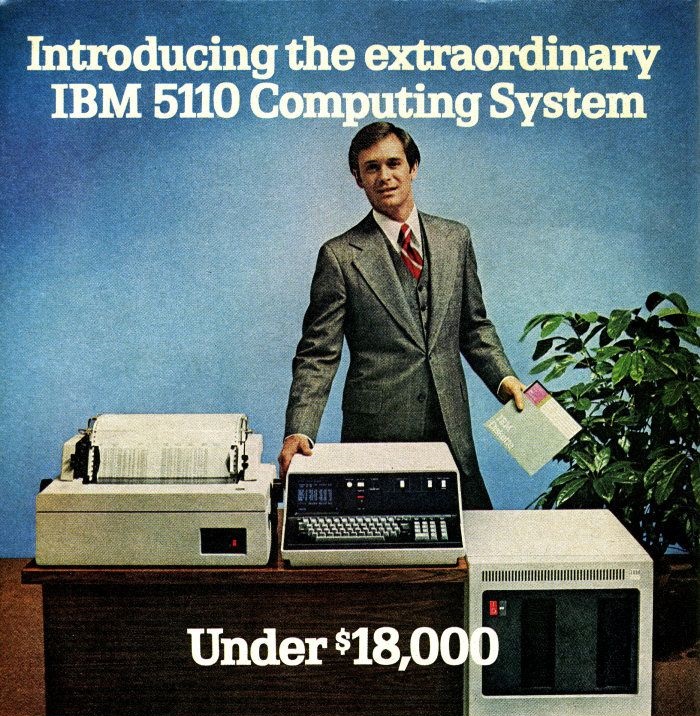
Strategic Selling was an approach that provided salespeople, already equipped with the basic skills propagated by PSS, with the tools for planning and managing large and complex accounts. Strategic Selling added very little to sales processes, though it did introduce a methodology of planning for large and complex accounts. The methodology that underpins the Strategic Selling approach is, however, flawed, given that no actual skillset was outlined in order to enable salespeople to change their behaviour from product focused selling to complex, consultative selling in large and key accounts.
1980s to early 1990s
One of the more successful sales methodologies that evolved after Needs Satisfaction Selling, was Neil Rackham’s SPIN Selling (Consultative Selling).
The protocol developed and in use in Needs Satisfaction Selling (which by now had become the standard for selling on a global scale), was no longer adequate. Something more was needed. In his classic work, SPIN Selling (Neil Rackham – 1988) showed how fundamental sales skills and techniques (as proposed by PSS) could be used to ask the right kind of questions and actually reduce the need to sell, stimulating the opportunity for professional salespeople to consult.
One of the most common strategies in almost all of the post PSS sales methods (and most particularly in Rackham’s SPIN) is best described as the “hurt and rescue” approach to selling. The salesperson finds out the problem the customer has and identifies what “hurts” the customer and then “rescues” the customer by introducing the features and benefits of the products being sold.
SPIN took the concept of “hurt and rescue” to a new level. Gone was the concept of identifying and handling customer objections. Although SPIN still relied on an introduction and pre-call research, the entire focus of this Consultative Selling method was based on using questioning techniques to help customers become self-aware. SPIN relied on four different questions to help customers “rescue” themselves:
Situational Questions in which the salesperson made an attempt to find out some background that could be used to gauge the buyer’s business situation and understand the context of the issues that would be used in the sales process.
Problem Questions were asked to uncover what “hurt” the prospect. The trap here, created by asking these types of questions so early in the sales cycle, was that salespeople would ask questions related to the problems the customer had, that could be rescued by the salesperson’s
products. So, although SPIN positioned itself as a consultative, solutions oriented sales method, very much like PSS, it was another way to sell the company’s products rather than to really solve the buyer’s problems by providing a solution. Perhaps the only real difference was the depth to which SPIN took the questioning techniques in its more consultative approach.
Implication Questions were asked to bridge the gap between what the salesperson’s products or services could do, and the “hurt” uncovered by the salesperson. So instead of telling the customer what the features and benefits were, the salesperson would ask the customer to visualise the implications of the problem without having the product / solution.
Needs Payoff Questions represented the final phrase of SPIN. Having identified what hurt the prospect it was now up to the salesperson to rescue them by giving them something to identify how a solution would resolve the pain that was being felt.
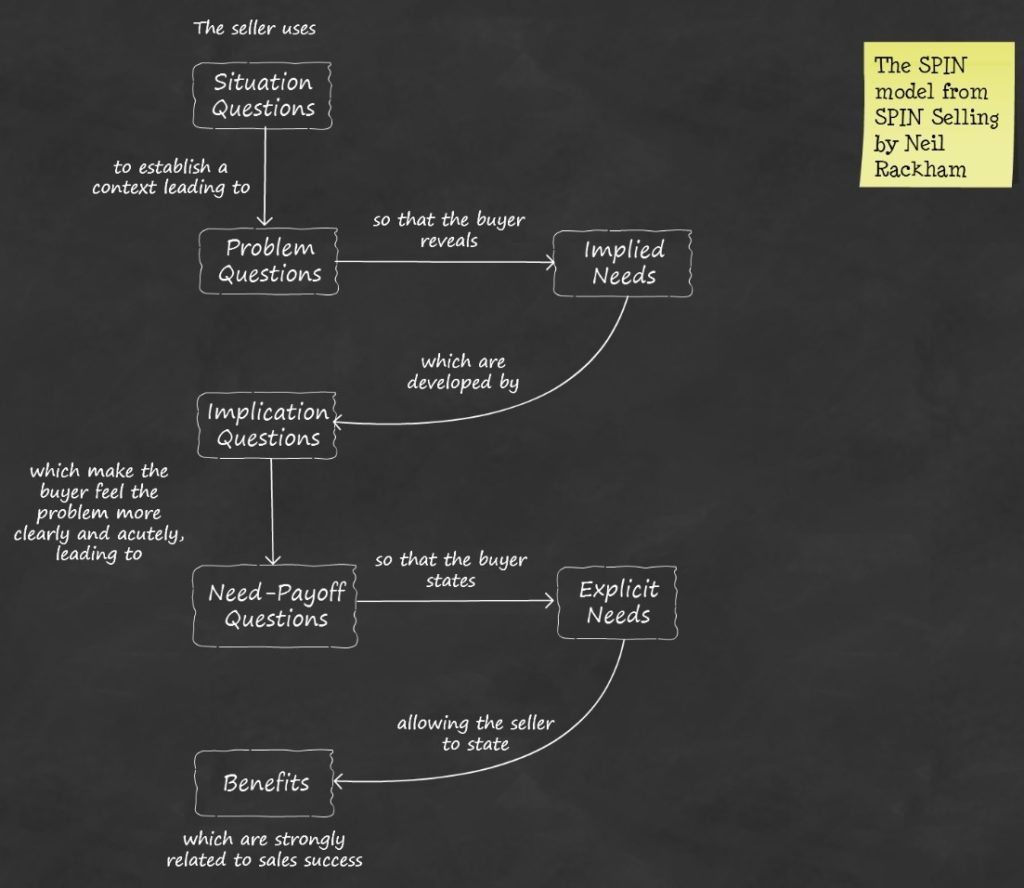
Overall, SPIN was, together with PSS, a combination of the most revolutionary approaches to selling. Whilst PSS introduced features and benefits with a focus on understanding the customer, SPIN took that process further and involved the customer in a consultative approach to selling. The key issue is why these two programmes – Need Satisfaction Selling and the Consultative Selling approach – were so successful? The reality is quite simple – they were both developed in response to the increased sophistication and demands of customers.
As far back as 1968 Xerox recognised that customers want choice. They don’t want salespeople to come in and tell them what to do, they want salespeople to consult with them, to be advisers and to help them make the right decision from a plethora of choices. They want salespeople to be sufficiently well trained to understand business and brave enough to propose new and sometimes revolutionary concepts as solutions. They expect professional salespeople to challenge their thinking and in that way, introduce new ideas.
Certainly in the case of SPIN, with its highly consultative approach to selling, the sales method is about the salesperson gaining an understanding of the customer. That foundation, laid by people such as Hammalian and Rackham is as relevant today, as it was then. Most of the sales methods offered today are based on PSS and/or SPIN, with added input from psychology and new research. In doing so, the new methodologies have clarified some elements of the former methods and given us a more refined evolution of what PSS and SPIN were.
Since the 1980s a range of other organisations also started developing sales methods, usually designed to support and promote their sales training programmes rather than to introduce improvements in sales methodology.














